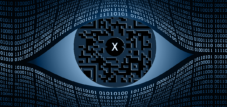
Securing competitiveness: Use of the GS Data Matrix Code (DMC) in the technical industry – Digital twins, IoT, Industry 4.0 and 5.0 – Image: Xpert.Digital
Key technology for Industry 4.0 & 5.0: The GS1 Data Matrix Code in focus
The industrial world is at a turning point where digitalization, automation, and networking are revolutionizing how companies operate and compete. In this context, the use of the GS1 Data Matrix Code (DMC) is proving to be a key technology. From optimizing the supply chain and promoting transparency to integrating smart technologies, the DMC enables companies to make processes more efficient and develop new business models.
Especially for Industry 4.0 and the transition to Industry 5.0, the GS1 Data Matrix code provides an indispensable foundation for connecting the physical and digital worlds. A prime example of its successful application is Schaeffler, a leading global technology company, which makes a crucial contribution to digitalization through the marking of rolling bearing components.
What is the GS1 Data Matrix code?
The GS1 Data Matrix code is a two-dimensional barcode that can encode enormous amounts of information in a very small space. With its compact format and highsegenit is particularly suitable for marking technical components.
Features and benefits
- Space efficiency: The DMC can store extensive information such as serial numbers, production data, or expiration dates in a very small space. This is ideal for small components, which are common in the technical industry.
- Versatility: In addition to product identification (e.g., via GTIN), other relevant data can be directly integrated.
- Robustness: Even if damaged, the code remains readable thanks to error correction mechanisms. This is of great importance in demanding industrial environments.
- Direct Part Marking (DPM): The direct marking of components enables permanent identification – ideal for durable products.
Application in the technical industry
The GS1 Data Matrix code is used in numerous areas of the technical industry. It not only drives digitalization forward but also offers practical solutions to key challenges.
Key areas of application
1. Traceability
The DMC enables seamless product tracking throughout the entire supply chain. Companies can ensure transparent documentation through the digital linking of product and process data.
2. Anti-counterfeiting protection
In the automotive aftermarket, the DMC is used as a MAPP code (Manufacturers Against Product Piracy) to guarantee the authenticity of components. Customers and partners can thus easily verify the origin and authenticity of products.
3. Digital Twin
The GS1 Data Matrix code forms the basis for creating a digital twin. By uniquely identifying a physical object, all relevant information can be digitally linked. This facilitates the simulation, analysis, and optimization of products.
4. Maintenance and repair
With a simple scan of the DMC, technicians gain access to product-related information such as maintenance history, operating instructions, or spare part numbers. This reduces downtime and increases efficiency.
Example: Schaeffler and rolling bearings
A prime example of the use of the GS1 Data Matrix code is the company Schaeffler. As a global player in the field of rolling bearing technology, Schaeffler has successfully integrated the DMC into its production and business processes.
Suitable for:
Innovations at Schaeffler
1. Standardization and ECC200 compliance
Schaeffler uses the GS1 standard to ensure that the marking is compatible and interoperable worldwide.
2. Digital Twin
Schaeffler marks its rolling bearing components with unique DMCs, which serve as the basis for digital twins. These digital representations enable precise monitoring and analysis throughout the entire life cycle of a product.
3. Smart EcoSystem
The DMC is a key component of Schaeffler's "Smart EcoSystem". This networked system offers customers a flexible, scalable, and comprehensive business model for Industry 4.0 applications. It enables the integration of IoT technologies and real-time communication between various stakeholders.
4. Efficient data exchange
The use of the DMC enables the efficient exchange of product-specific data between suppliers, manufacturers, and operators. This promotes collaboration along the entire value chain.
Significance for Industry 4.0 and 5.0
The GS1 Data Matrix code is a key factor for the successful implementation of Industry 4.0 and the transition to Industry 5.0. Connecting physical objects with digital networks creates new opportunities for automation, efficiency, and sustainability.
IoT integration
The DMC acts as an interface between physical products and digital systems. It enables the integration of components into IoT networks, allowing for continuous, real-time data acquisition and processing. This promotes intelligent production processes.
Predictive maintenance
Combining DMC data with sensor data enables predictive maintenance. Companies can identify and resolve potential problems early, before they lead to breakdowns. This increases operational efficiency and reduces costs.
sustainability
Through seamless traceability and improved information exchange, the DMC supports sustainable practices. Companies can use resources more efficiently and optimize the product lifecycle.
Human-machine interaction (Industry 5.0)
In Industry 5.0, the focus is shifting to collaboration between humans and machines. The DMC supports this development by providing an intuitive interface that allows people to access relevant information quickly and easily.
Matches:
- Differences between Industry 4.0 and Industry 5.0
- Industry 5.0: Origin, meaning and further development compared to Industry 4.0 for industrial production and mechanical engineering
The GS1 Data Matrix code is more than just a barcode.
The GS1 Data Matrix Code is more than just a barcode – it's a key to a connected and digitized industry. Companies like Schaeffler demonstrate how this technology can be used to optimize processes, develop new business models, and remain competitive in the long term. From traceability and enhanced anti-counterfeiting capabilities to integration with IoT systems, the DMC offers numerous opportunities to successfully meet the challenges of modern industry.
With regard to Industry 4.0 and 5.0, it becomes clear that companies that strategically use the GS1 Data Matrix Code are ideally equipped for the future.
Suitable for:
Our recommendation: 🌍 Limitless reach 🔗 Networked 🌐 Multilingual 💪 Strong sales: 💡 Authentic with strategy 🚀 Innovation meets 🧠 Intuition
At a time when a company's digital presence determines its success, the challenge is how to make this presence authentic, individual and far-reaching. Xpert.Digital offers an innovative solution that positions itself as an intersection between an industry hub, a blog and a brand ambassador. It combines the advantages of communication and sales channels in a single platform and enables publication in 18 different languages. The cooperation with partner portals and the possibility of publishing articles on Google News and a press distribution list with around 8,000 journalists and readers maximize the reach and visibility of the content. This represents an essential factor in external sales & marketing (SMarketing).
More about it here:
Technology of the future: How the GS1 Code is redefining supply chains and business models – as a key to smart networking
The industrial world is at a turning point where digitalization, automation, and networking are revolutionizing how companies operate and compete. In this context, the use of the GS1 Data Matrix Code (DMC) is proving to be a key technology. From optimizing the supply chain and promoting transparency to integrating smart technologies, the DMC enables companies to make processes more efficient and develop new business models.
Especially for Industry 4.0 and the transition to Industry 5.0, the GS1 Data Matrix code provides an indispensable foundation for connecting the physical and digital worlds. A prime example of its successful application is Schaeffler, a leading global technology company, which makes a crucial contribution to digitalization through the marking of rolling bearing components.
Future-oriented technologies require the comprehensive integration of digital tools and standards to remain competitive in the increasingly complex technical industry. The GS1 Data Matrix code will therefore play a key role in numerous sectors. From the automotive and aerospace industries to medical technology, this technology provides a foundation for innovative approaches to ensure efficiency, safety, and sustainability.
Here are the most important sectors of the technical industry for which the GS1 Data Matrix code will be crucial in the future to remain competitive:
1. Automotive industry
- Spare parts management: Ensuring the authenticity and traceability of components.
- Manufacturing: Integration into IoT-enabled production systems to optimize the supply chain.
- Predictive Maintenance: Data collection for early fault detection and maintenance planning.
2. Mechanical engineering
- Product identification: Traceability of complex machine components.
- Digital twin: Creation of digital images of machines for monitoring and simulation.
- Maintenance: Simplifying repair processes through rapid information provision.
3. Electrical Engineering and Electronics
- Component identification: Tracking of circuits, chips and modules.
- Quality assurance: Prevention of counterfeits through unambiguous identification.
- IoT integration: Seamless networking of products in intelligent systems.
4. Aerospace
- Safety standards: Traceability of safety-critical components such as engine parts.
- Compliance: Fulfillment of international regulations and documentation requirements.
- Life cycle management: Linking physical components with digital information.
5. Medical technology
- Instrument marking: Unique identification of surgical and medical devices.
- Sterility verification: Integration of batch numbers and production data.
- Regulatory requirements: Compliance with global regulations such as UDI (Unique Device Identification).
6. Energy and utilities sector
- Plant identification: Traceability of components in power grids and power plants.
- Sustainability: Monitoring of components to improve resource utilization.
- IoT solutions: Linking sensors and systems for smart energy systems.
7. Logistics and Supply Chain Management
- Real-time tracking: Seamless monitoring of goods flows.
- Optimized warehousing: Automation of inventory management and replenishment planning.
- Transparency: Strengthening trust in global supply chains.
8. Packaging industry
- Smart packaging: Integration of DMC for product information and recycling instructions.
- Traceability: Meeting the requirements of the food and pharmaceutical industries.
- Anti-counterfeiting protection: Protection of branded products from counterfeits.
9. Chemical and pharmaceutical industry
- Batch tracking: Traceability of raw materials and finished products.
- Regulatory compliance: Fulfillment of legal requirements such as serialization obligations.
- Customer safety: Providing transparent information about origin and quality.
10. Building and Construction Technology
- Component identification: Tracking of building materials and modules.
- Smart Buildings: Integration of IoT devices for energy efficiency and maintenance optimization.
- Documentation: Creation of digital twins for construction and maintenance work.
11. Textile and clothing industry (Technical textiles)
- Product tracking: Ensuring the quality and origin of technical textiles.
- IoT-enabled materials: Linking wearables and smart textiles with digital platforms.
- Sustainability: Traceability to support environmentally friendly practices.
12. Agricultural and forestry technology
- Machine identification: Traceability of tractors, combine harvesters and forestry machines.
- Smart Farming: Linking agricultural equipment with IoT systems.
- Life cycle optimization: Data-driven planning of maintenance and spare parts.
We are there for you - advice - planning - implementation - project management
☑️ SME support in strategy, consulting, planning and implementation
☑️ Creation or realignment of the digital strategy and digitalization
☑️ Expansion and optimization of international sales processes
☑️ Global & Digital B2B trading platforms
☑️ Pioneer Business Development
I would be happy to serve as your personal advisor.
You can contact me by filling out the contact form below or simply call me on +49 89 89 674 804 (Munich) .
I'm looking forward to our joint project.
Xpert.Digital - Konrad Wolfenstein
Xpert.Digital is a hub for industry with a focus on digitalization, mechanical engineering, logistics/intralogistics and photovoltaics.
With our 360° business development solution, we support well-known companies from new business to after sales.
Market intelligence, smarketing, marketing automation, content development, PR, mail campaigns, personalized social media and lead nurturing are part of our digital tools.
You can find out more at: www.xpert.digital - www.xpert.solar - www.xpert.plus

